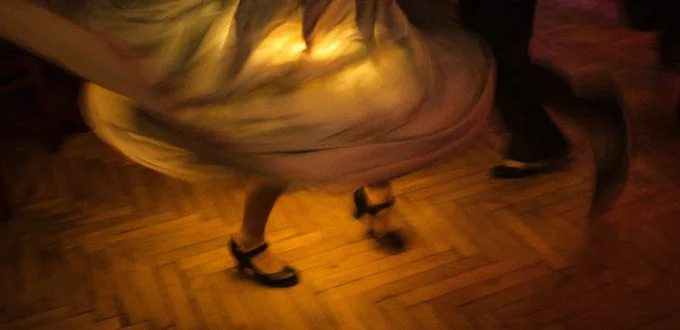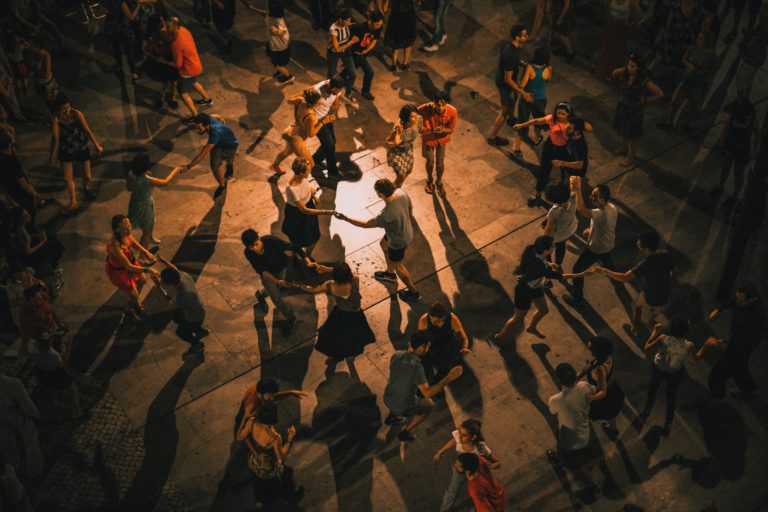You want to stay independent and make meaningful contributions to your community and family for many, many, MANY years to come. Your community and your network (family, friends) need you too – so it is important that you keep your mental and physical health in tip-top shape. Did you know you can engage in activities that bring you joy and – at the same time – enhance your brain health?
Dancing is good for your brain and your body.
Dancing is a pattern of rhythmic bodily movements in space and time – usually performed in sync with a musical beat. It brings with it a feeling of joy and fun, and it promotes social interactions, movement and a sense of community (if you’re dancing with others). But it is hard for adults aged 60+ living in Toronto to find places dance. Most clubs are geared towards a younger generation and many of the classes that do exist are costly. Stick with me and I will share some local opportunities and easy ways to add more dance to your life.
My mom is 75 and she absolutely loves to dance. She is usually the first one out on the living room floor at any big family gathering, and at Christmas time my dad will have to take out his hearing aids if he has any hopes of having a quiet moment amidst the blaring Christmas carols with my mom’s loudest “singing” overlaid on top. Her heart melts at the sound of any Elvis tune, or a powerful new age female anthem like “Girl on Fire” by Alicia Keys. You can read more about my mom’s healthy habits here; but dancing is one of her healthy habits that warrants a closer look.
The beauty of dance as a form of exercise is that it can happen almost anywhere and the healthy boost to your brain and body will be all the same.
How Dancing Boosts Health
The magic of dance and its positive impact on our health is that it combines cardiovascular (oxygen-driven muscle movement) and motor (balance and posture) fitness, with the memories and emotions of our favourite music. It also requires timing sequences of movement (spontaneous or choreographed and learned) to a beat.
Dancing is unique because it is a physical, emotional, and often social activity. It includes sensory stimulation, motor coordination, as well as musical beats and vibrations. It is the special interaction of all of these components that generate three key beneficial outcomes:
Brain
Dancing gives your brain a special boost, because it involves wide-spread brain activity, as well as learning patterns of movement and sequencing them to a beat.
Body
Dancing improves cardiovascular health, muscle and bone strength (particularly lower body), flexibility, agility, posture, balance, and mobility.
Promotes Successful Aging
Dancing generates and improves social relations, helps to build community, increases confidence, creates feelings of enjoyment and happiness, and also leads to a reduction in falls.
Research Reveals the Top Five Reasons to Dance:
Research (Keogh et al., 2009) on a variety of different types of dancing – from ballroom to tango to aerobic – shows that rhythmic movement to music can substantially benefit the health of older adults.
1: Stronger muscles and bones – Compared with non-dancers, older dancers showed improved muscle endurance (strength) and had greater bone-mineral content (stronger bones).
2: Positive impact on memory and attention – Research by Predovan et al. (2018) revealed that dance classes (ranging from 10 weeks to 18 months; class duration ranging from 45-90 minutes) led to maintained or improved mental abilities (e.g., memory and attention) in adults aged 60+ who had no formal dance training. The reason dance classes have a beneficial effect on memory and attention is because of the complexity associated with coordinating learning a sequence of body movements to a musical beat.
3: Better health status – Research shows that older dancers, on average, have reduced body fat, and a lower prevalence of diabetes and hypertension, as compared to non-dancers. Older adults who took dance lessons also showed lower cardiovascular issues and reduced cholesterol.
4: Improved flexibility and mobility – Older adults who danced were shown to be more flexible, and they also demonstrated greater muscle endurance and walking speed (e.g., Hui et al., 2009).
5: Lower incident of falls – Dancing has been scientifically linked to better balance and a reduction in falls (Jeon et al., 2005). *Around 20-30% of Canadian seniors fall every year (see Government of Canada Report). As such, it is very important to engage in activities that promote balance and strength – such as dancing – to reduce your risk of falling (click here to read more about the powerful impact of physical activity on overall health).
People dance because they want to have fun with friends – people like listening to their favourite songs and moving to the beat with others. The positive emotional impact of socializing and music on overall brain health cannot be overstated, and research demonstrates that social dancing has a positive effect on the health of older adults (Roberson & Pelclova, 2014). So, whether you’re participating in an organized dance class or socially dancing with friends or family, it is important to get moving!
Looking for Dance Classes Near You?
1: The City of Toronto website has information about drop-in dance classes for adults aged 60+ here
2: The City of Toronto website also has information on instructional dance classes for older adults here
3: Canada’s National Ballet School (NBS): Sharing Dance Seniors program
From the NBS website, I pulled the following information about their program:
What is Sharing Dance Seniors?
This 60 minute dance class is designed to be accessible to seniors with varying levels of physical ability.
Classes begin with seated dancing, followed by dancing in a standing position.
Standing sections of the class include seated options for those who prefer to continue dancing in a seated position.
Classes are designed to be physically, cognitively, and creatively stimulating and incorporate a variety of different musical and dance styles.
These classes take place every Friday morning from 945-1045am
Term Dates for 2018-19
Fall Term: September 21st to December 14th*
Winter Term: January 18th to April 12th
Spring Term: April 26th to June 14th
*The cost is typically $325/term, but it is FREE for the FALL TERM thanks to the generous support of donors. Their last class will be on Dec 14th; but, you are welcome to come and try a class before the new year, if you wish.
For more information about this program, visit the NBS website here or contact Nancy Lehan, 416.964.3780 x2215 | nlehan@nbs-enb.ca
—
For all dance related activities, it is important to wear comfortable clothing and walking or running shoes.
Also, know your own physical limits and dance within them. If you are unsure, consult with your physician.
Conclusion
Dancing is a fun, solo or social activity with many proven health benefits. We now have substantial scientific evidence that supports the positive impact that dancing has on our brain and body, promoting successful aging. So, if you aren’t already dancing around your computer, ipad or cell phone at this uplifting news, get on your comfortable shoes and start moving your body today!
Need a tune to get you grooving right now? Look no further: Dance to the Music – Sly & The Family Stone
Where do you like to dance in the city? How has dancing helped you to stay healthy and active? Be sure to leave a comment below!
Disclaimer – this post is for information purposes only. Be sure to consult a physician before making any changes to your dance or exercise routine.




